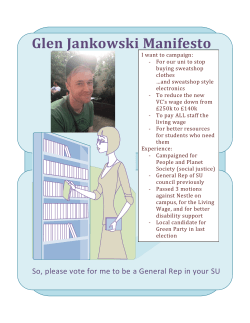
Raising the Minimum Wage to $12.50 in Colorado:
Raising the Minimum Wage to $12.50 in Colorado: Fact Sheet 3/20/2015 Low-wage workers are falling farther behind. Working full time at minimum wage is not enough to support the basic cost of living in Colorado. Raising the minimum wage to $12.50 by 2020 makes good on the promise of work as a pathway out of poverty and will spur economic growth across the state. The Current Minimum Wage is Not Enough to Survive On The minimum wage in Colorado is currently $8.23/hour. At $8.23/hour, however, annual full-time income totals only $17,118—below the federal poverty level of $20,090 for a family of three in 2015.i Today, it is difficult for a single parent to achieve self-sufficiency by working a full-time year round minimum wage job. But that was not always the case. Between 1938—when the minimum wage was established—through the 1960s, the minimum wage provided a more adequate floor for wages and grew at the same pace as productivity. At its peak value in 1968, the minimum wage was equal to a little more than half of what the average production worker made. Over time, the value of the minimum wage has eroded and the wage gap between minimum wage workers and the average American wage earner has grown significantly. Today, a minimum wage worker in Colorado only makes about one-third of the average wage.ii Contrary to popular belief, teenagers and young people make up a small fraction of the workers who earn minimum wage. In fact, only 12.5 percent of minimum wage workers are 20 years of age or younger. The biggest age group earning minimum wage consists of those 20 to 29. The average age of a minimum wage earner is 35. Low-Wage Workers in Colorado The majority of minimum wage workers are older (over the age of 20) and work more than 20 hours a week.iii Over half of workers earning minimum wage are women. About 600,000 Coloradans—just over one-quarter of the labor force—make less than $12/hour.iv Proposal: $12.50 by 2020 Refer to the voters: The bill would refer a measure to the voters to increase the minimum wage. Colorado’s minimum wage is set in the state constitution, and can only be changed by the voters. Phased-in: $12.50 per hour by 2020 to be phased in over four years. The minimum wage would increase by about a $1/hour per year starting in 2017. This is consistent with historical increases in the federal minimum wage dating back to 1938—which have been on average about 10 percent of the previous minimum.v The minimum wage would be increased according to the following schedule: 2017: $9.50 2018: $10.50 2019: $11.50 2020: $12.50 Tipped Wages: Maintain the current tip credit of $3.02, ensuring that increases in the minimum wage also increase the wages of tipped workers. Adjusted Annually: The minimum wage would be adjusted annually for inflation beginning January 1, 2021 using the CPI-U for Greeley-Boulder-Denver. Annual adjustments will be either zero or positive. Overwhelming Public Support Fourteen states took action to raise their statewide minimum wage in 2014. CT, DE, HI, MD, MA, MI, MN, RI, VT, WV, and D.C. enacted increases during the 2014 session, while voters in AK, AR, NE and SD approved minimum wage increases through ballot measures. According to a recent national poll, 75 percent of Americans support a proposal to increase the minimum wage in stages to reach $12.50 by 2020. The poll found substantial bi-partisan support: 92 percent of Democrats; 73 percent of independents; and 53 percent of Republicans support a phased-in minimum wage of $12.50 by 2020.vi Strengthening the Economy by Improving Pay i The best available research has consistently demonstrated that raising the minimum wage is unlikely to have any negative impacts on employment, both broad based, and in the sectors most likely to hire minimum wage workers.vii Empirical economic comparisons of contiguous counties—the gold standard in methodology—find no evidence of a negative employment effect of minimum wage increases. They do find, however, modest wage increases for those who earn near the minimum wage, suggesting that the population impacted is not limited to just those who earn the minimum wage.viii Further, low and middle-income workers are more likely to spend pay increases than other income groups. The additional spending would have an overall positive effect on the economy stimulating increased consumer demand and job growth. U.S. Department of Health and Human Services, “Annual update of the HHS poverty guidelines 2015,” available at: https://www.federalregister.gov/articles/2015/01/22/2015-01120/annual-update-of-the-hhs-poverty-guidelines. ii According to data from the Bureau of Labor Statistics, the average hourly wage for production workers in Colorado in 2014 was $25.03 and the average hourly wage of all private nonfarm workers was $26.29. iii National Employment Law Project, “Economic impacts of 10 state minimum wage increases on January 1, 2013,” available at: http://www.nelp.org/page/-/rtmw/uploads/January-1st-Minimum-Wage-Increases-Demographic-Impact.pdf?nocdn=1 iv Colorado Fiscal Institute analysis of Bureau of Labor Statistics, Occupational Employment Statistics for Colorado for 2013. v David Cooper, “Raising the Federal Minimum Wage to $10.10 Would Lift Wages for Millions and Provide a Modest Economic Boost,” (Washington, DC: Economic Policy Institute, 2013). vi Hart Research Associates, “Support for a Federal Minimum Wage of $12.50 or above” (2015), available at http://www.nelp.org/page/-/rtmw/Minimum-Wage-Poll-Toplines-Jan-2015.pdf?nocdn=1 vii John Schmitt, “Why Does the Minimum Wage Have No Discernible Effect on Employment?” (Washington, DC: Center for Economic Policy Research, 2013), available at http://www.cepr.net/index.php/publications/reports/why-does-theminimum-wage-have-no-discernible-effect-on-employment Center for Economic and Policy Research. viii Arindrajiti Dube, T. William Lester, and Michael Reich, “Minimum Wage Effects Across State Borders: Estimates Using Contiguous Counties,” Institute for Research on Labor and Employment, IRLE Working Paper No. 157-07 (2010), available at http://www.irle.berkeley.edu/workingpapers/157-07.pdf.
© Copyright 2025









